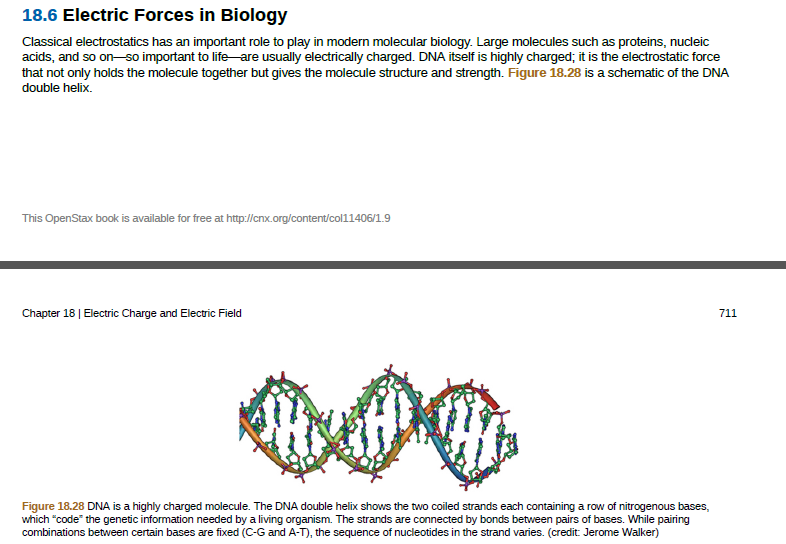18.6 Electric Forces in Biology Classical electrostatics has an important role to play in modern molecular biology. Large molecules such as proteins, nucleic acids, and so on-so important to lifeare usually electrically charged. DNA itself is highly charged; it is the electrostatic force that not only holds the molecule together but gives the molecule structure and strength. Figure 18.28 is a schematic of the DNA double helix. This OpenStax book is available for free at http://cnx.org/content/col11406/1.9 Chapter 18 | Electric Charge and Electric Field 711 Figure 18.28 DNA is a highly charged molecule. The DNA double helix shows the two coiled strands each containing a row of nitrogenous bases, which "code" the genetic information needed by a living organism. The strands are connected by bonds between pairs of bases. While pairing combinations between certain bases are fixed (C-G and A-T), the sequence of nucleotides in the strand varies. (credit Jerome Walker)
18.6 Electric Forces in Biology Classical electrostatics has an important role to play in modern molecular biology. Large molecules such as proteins, nucleic acids, and so on-so important to lifeare usually electrically charged. DNA itself is highly charged; it is the electrostatic force that not only holds the molecule together but gives the molecule structure and strength. Figure 18.28 is a schematic of the DNA double helix. This OpenStax book is available for free at http://cnx.org/content/col11406/1.9 Chapter 18 | Electric Charge and Electric Field 711 Figure 18.28 DNA is a highly charged molecule. The DNA double helix shows the two coiled strands each containing a row of nitrogenous bases, which "code" the genetic information needed by a living organism. The strands are connected by bonds between pairs of bases. While pairing combinations between certain bases are fixed (C-G and A-T), the sequence of nucleotides in the strand varies. (credit Jerome Walker)
Human Heredity: Principles and Issues (MindTap Course List)
11th Edition
ISBN:9781305251052
Author:Michael Cummings
Publisher:Michael Cummings
Chapter8: The Structure, Replication, And Chromosomal Organization Of Dna
Section: Chapter Questions
Problem 12QP: DNA contains many hydrogen bonds. Are hydrogen bonds stronger or weaker than covalent bonds? What...
Related questions
Concept explainers
Question
Electric Forces in Biology
• Describe how a water molecule is polar.
• Explain electrostatic screening by a water molecule within a living cell.

Transcribed Image Text:18.6 Electric Forces in Biology
Classical electrostatics has an important role to play in modern molecular biology. Large molecules such as proteins, nucleic
acids, and so on-so important to lifeare usually electrically charged. DNA itself is highly charged; it is the electrostatic force
that not only holds the molecule together but gives the molecule structure and strength. Figure 18.28 is a schematic of the DNA
double helix.
This OpenStax book is available for free at http://cnx.org/content/col11406/1.9
Chapter 18 | Electric Charge and Electric Field
711
Figure 18.28 DNA is a highly charged molecule. The DNA double helix shows the two coiled strands each containing a row of nitrogenous bases,
which "code" the genetic information needed by a living organism. The strands are connected by bonds between pairs of bases. While pairing
combinations between certain bases are fixed (C-G and A-T), the sequence of nucleotides in the strand varies. (credit Jerome Walker)
Expert Solution
This question has been solved!
Explore an expertly crafted, step-by-step solution for a thorough understanding of key concepts.
This is a popular solution!
Trending now
This is a popular solution!
Step by step
Solved in 3 steps with 1 images

Knowledge Booster
Learn more about
Need a deep-dive on the concept behind this application? Look no further. Learn more about this topic, biology and related others by exploring similar questions and additional content below.Recommended textbooks for you

Human Heredity: Principles and Issues (MindTap Co…
Biology
ISBN:
9781305251052
Author:
Michael Cummings
Publisher:
Cengage Learning

Anatomy & Physiology
Biology
ISBN:
9781938168130
Author:
Kelly A. Young, James A. Wise, Peter DeSaix, Dean H. Kruse, Brandon Poe, Eddie Johnson, Jody E. Johnson, Oksana Korol, J. Gordon Betts, Mark Womble
Publisher:
OpenStax College

Human Heredity: Principles and Issues (MindTap Co…
Biology
ISBN:
9781305251052
Author:
Michael Cummings
Publisher:
Cengage Learning

Anatomy & Physiology
Biology
ISBN:
9781938168130
Author:
Kelly A. Young, James A. Wise, Peter DeSaix, Dean H. Kruse, Brandon Poe, Eddie Johnson, Jody E. Johnson, Oksana Korol, J. Gordon Betts, Mark Womble
Publisher:
OpenStax College